How to analyze traffic quality

Hi, I am Uncle Dimitry, the person who created Safe-Swaps back in 2005 and later created Udimi in 2015 with my team of talented Ukrainian programmers.
During this 20-year journey, our mission has remained unchanged: to ensure that our buyers receive top-quality traffic and our sellers receive their payments.
Nowadays, a significant amount of fraud occurs on both sides of transactions. Some sellers attempt to deliver fake or useless traffic, while some buyers try to get a free ride or pay with a stolen card. Through these experiences, I have gained substantial knowledge in both payment and click fraud.
Little later I'll write my story, how I lost $25,000+ USD buying traffic on Google, Facebook and Reddit, which in my opinion was 99.99% fake. I was shocked by this level of fake traffic from top networks.
After I've contacted Google's support, some stupid dumbass lied to me that "we looked at everything and all is fine". After this message, the dialog with that retarded Google's employee was over. He didn't bother to reply me even after I told that I am going to initiate a chargeback.
In the light how blatantly they sell you fake traffic, it is important to know at least how to spot it.
Thieves are stupid
Many thieves lack intelligence. In fact, a person with a good head on their shoulders would not choose to become a thief. Some thieves attempt to imitate smart individuals, but if someone resorts to theft, they are most likely a foolish and lazy person seeking to make easy money through dishonest means. Consequently, they often engage in activities that are easily detected.
Level 0
Let's start from the most primitive tactic to more advanced ones. On the level 3 you will discover what type of fraud traffic I received from Google.
Ok, you received the traffic and your click stats look like: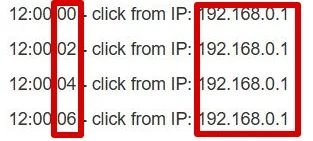
Do you see the pattern? If you don't, please close this page and never buy traffic anymore... I am dead serious, if you don't see a pattern here, you are too retarded to get into this.
Ok, back to the pattern: we can see the most stupid click fraud possible: every click comes from the same IP and it has exact delay of 2 seconds between visits.
Level 1
Ok, you received the traffic and your click stats look like: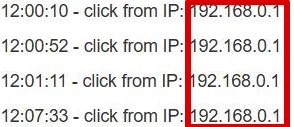
The fraudster attempted to use a time randomizer, but he was so careless that he kept clicking from the same IP address. Some scams are so poorly executed that they cannot even afford access to proxy services to rotate IPs.
Level 2
Your click stats look like: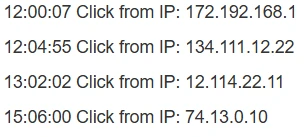
This time, the fraudster used a time randomizer and different proxy servers to rotate IPs. To spot this, you need to look at the IP usage type. At Udimi, we show whether an IP came from a home/mobile connection or a data center.
A data center connection could be completely fine, as some people browse the web for personal interests using corporate connections at work.

On this screenshot we can see that it was a Google's cache bot visit. The sellers can't control that and is not responsible for this click.

Here's another example: ping bot from Gmail. Obviously the seller sent the solo ad and Gmail's bot tried to validate the link by pinging it.
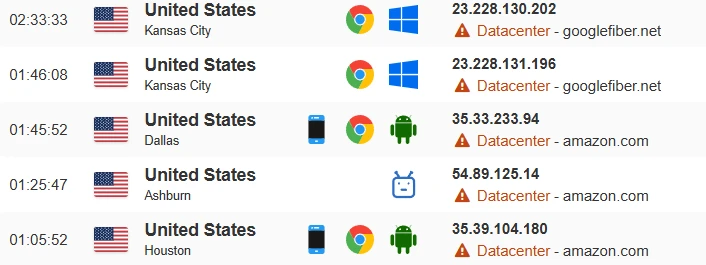
However, if the majority of connections come from data centers, that's a red flag. The Udimi filter automatically detects the connection type for every click and will block these clicks if they exceed a certain threshold. If you are buying traffic in the wild market, you should check this yourself.

Device patterns
You should also look for other patterns, like device types and browsers. For example, your stats look like:
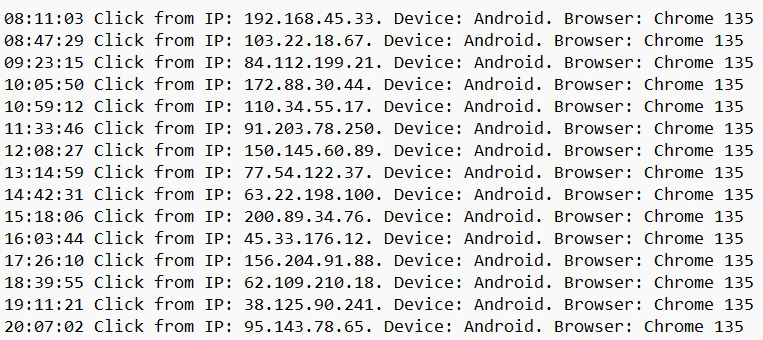
See the pattern: all devices are the same. Browsers are the same and browser versions are the same. This s fake traffic, generated by bots, but the scam forgot (or didn't care) to randomize browsers and devices.
Level 3
Now we are entering into the terrain of more advanced scam techniques. Your statistics looks perfectly fine, like this:
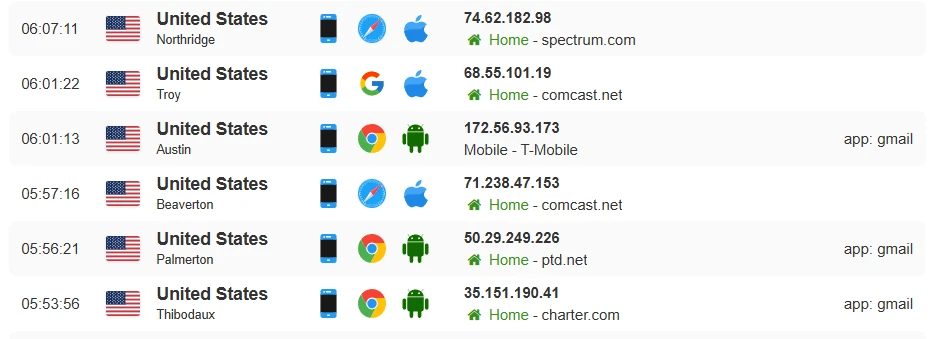
When click statistics is fine, you should check your list subscribers. What to look for:
Subscription timeframe
Very important: before comparing this, make sure your click tracker's time zone, server's timezone and autoresponder's timezones match. If not, make convert time to one timezone first, UTC for example.
If all your clicks arrived to your site after registrations, that's clear fraud. It is impossible if a person registered on your site even before visiting it.
Subscriber's IP addresses
IP address and other info of your subscribers must match the one this person landed on your site.
Basically, if you have a subscriber johnsmith@gmail.com with IP 192.168.1.1 with Chrome browser on a desktop, then there should be a click in your stats with exactly the same info.
As a side note: there may be discrepancies due to user's internet connection issues and many other 100% legit factors, like VPN usage, privacy settings and adblockers. But overall percentage should be very low (2% or less)
Email address patterns
Here are some examples

Do you see the pattern? First: all emails are from Gmail. While Gmail is the most popular provider in the world, it could not be that 100% of your subscribers are using it. Second: all emails have the same structure. First name Last name dot 5-digit rando number (namesurname.#####@gmail.com)
That's 100% fake. Again: it could be that somebody registered email like that, but not all the subscribers.
Open rates
To understand this, you should refer to your past mailings, as open rates and clicks inside emails depend on many different factors. There’s no universal benchmark for everyone.
Factors that influence open rates include:
- How spammy your message appears to spam filters
- How relevant and engaging your message is to the reader
- How compelling the subject line is
- The timing of the email in the recipient’s local time. If it’s delivered while they’re asleep, it could get buried among other emails
- Your server’s (or autoresponder’s) reputation with email providers, which affects deliverability
- ... many more
These are just a few of the factors. Over time, you should start to see your typical performance metrics. If you’re buying traffic and users aren’t converting, clicking, or even opening your emails, despite using a proven sequence, that’s a sign you need to investigate further.
Level 4
There are more ways that fraudsters use to cheat innocent buyers, but they are out of the scope of this article which is about basics of analyzing traffic quality. I cover them in the article How scams cheat solo ad buyers
What to do?
On Udimi this won't happen to you, because we have filters in place to control every step of the process. In addition, we have profiles for every seller with all their ratings, non-removable, both positive and negative.
But if you bought traffic on the wild market, there's not much you can do when they defraud you: try to talk with your seller, demand a refund, post review on social networks.